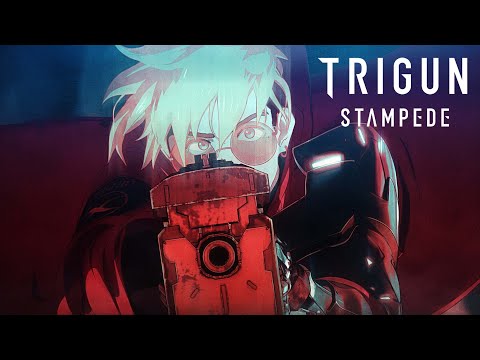
When Studio Orange announced that they were making Trigun Stampede, I was pleasantly surprised. Trigun is a title that a lot of anime and manga fans around the turn of the 21st century cut their teeth on—I myself remember seeing it thanks to my school’s anime club. However, aside from a singular film in the form of 2010’s Trigun: Badlands Rumble, it hasn’t gotten much love, and it also isn’t as enduring in the general fandom consciousness as Cowboy Bebop. To be fair to both, they’re only vaguely similar, but they did come out around the same time and were anime convention staples together for years.
But here was a new Trigun TV series, and what’s more, it was clear that Trigun Stampede was going for an updated aesthetic. Anyone who’s familiar with the manga or anime remembers the iconic look of hero Vash the Stampede in his signature red trench coat and ultra-spiky hair—and both have been significantly altered for this remake. As I watched it, one thing became clear: While a lot of elements are similar to the 1990s anime, the story had been rearranged in noticeable ways. Where the previous iteration has a 50/50 balance of slapstick comedy via larger-than-life personalities and twist-filled science-fiction drama, Stampede is a lot more focused on telling a serious story. That said, I didn’t mind the changes, and was able to take all the changes in stride and appreciate them on their own terms.
But as I was going over how I feel about Stampede, a thought occurred to me. Why is it that I was able to easily accept a different Trigun, yet the very idea of a new anime remake of Cowboy Bebop feels wrong? I’m not even someone who reveres Cowboy Bebop as a sacred cow, though I think it’s excellent in many ways. (I know there’s the live-action Cowboy Bebop, but I consider adaptations like that their own separate topic regardless of quality, so I‘m setting that aside.)
What I think the difference comes down to is just the way each series generally approaches storytelling. Cowboy Bebop is like a finely tuned machine, intricate and delicately balanced to give a very specific experience. Removing even one or two gears can throw the entire thing off, and overhauling it entirely feels pointless. Trigun, on the other hand, comes across as more of a scrapbook. Narratives can still be formed, but the strengths of the individual elements are more important, and they can be rearranged in different ways.
This brings to mind an old favorite topic of mine: the contrast between “character” and “kyara” as written about by manga scholar Ito Go. Essentially, character is how a figure exists within their greater story, whereas kyara is how much of their identity can be maintained if divorced from their original context. I think neither Cowboy Bebop nor Trigun are severely lacking in either category, but the former has a relatively stronger emphasis on character, while the latter focuses more on kyara.
It’s why Trigun Stampede can be this more somber experience wholly lacking in things like a wacky black cat who makes cameos and meows a lot, yet still identifiably be Trigun. In fact, this new series can often feel like Trigun leaning in the direction of Cowboy Bebop without thoughtlessly aping it. So even though there’s a sequel to Stampede on the way that will actually incorporate more of the 1990s Trigun look, the new groundwork laid out makes me look forward to seeing both how similar and how different things get. And despite the fact that the franchise has its origins in the 1990s, I can’t help but wonder if the pacifist nature of Vash might actually resonate harder among fans today.